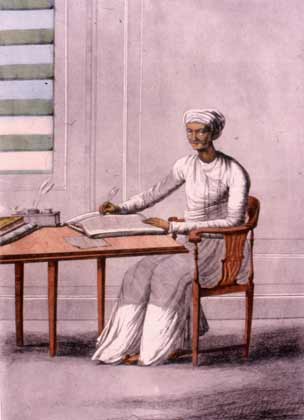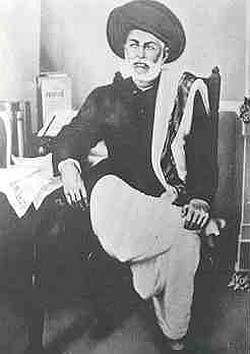
Pathare Prabhu is one of the Hindu communities found mainly in the Indian state of Maharashtra.

Pathare Prabhu is one of the Hindu communities found mainly in the Indian state of Maharashtra.
The Pathare Prabhus and the Chandraseniya Kayastha Prabhus (CKP) are considered sister communities, both being part of the 'Prabhu castes'. [1] Both Pathare Prabhu and CKP follow the Advaita Vedanta Smarta tradition of Hinduism propounded by Adi Shankara. [2]
Along with all the Maharashtrian Brahmin castes and the CKP, they are considered one of the 'high' or 'elite' castes of Maharashtra. [3]
The Pathare Prabhu, in the 19th century would to refer to Mumbai (then known as Bombay) as 'Desh' (country). They formed the "Union Club" under which were the five primary collectives of Girgaon, Mazagaon, Parel, Mahim and Worli. In 1887, they held a meeting at the "Desh" level in which it was decided to stop inviting "naikins" (dancers) to sing at the Upanayana (thread ceremonies or "munja") and marriage celebrations. Historians cite an incident where a Pathare Prabhu member who broke this rule two years later was socially outcast by the community. He sued for defamation but the British Court ruled against him. [4]
The Maratha caste is composed of 96 clans, originally formed in the earlier centuries from the amalgamation of families from the peasant (Kunbi), shepherd (Dhangar), blacksmith (Lohar), carpenter (Sutar), Bhandari, Thakar and Koli castes in Maharashtra. Many of them took to military service in the 16th century for the Deccan sultanates or the Mughals. Later in the 17th and 18th centuries, they served in the armies of the Maratha Empire, founded by Shivaji, a Maratha Kunbi by caste. Many Marathas were granted hereditary fiefs by the Sultanates, and Mughals for their service.

Baji Prabhu Deshpande was a general of the Maratha Army. He is known for his role in the Battle of Pavan Khind at Ghod Khind, where he sacrificed his life defending Shivaji from incoming Adil Shahi forces of Siddi Johar. He also was a landlord or Vatandar in the Maval region.

Bhalchandra Trimbak Ranadive, popularly known as BTR, was an Indian communist politician and trade union leader.

Kayastha or Kayasth denotes a cluster of disparate Indian communities broadly categorised by the regions of the Indian subcontinent in which they were traditionally located—the Chitraguptavanshi Kayasthas of North India, the Chandraseniya Kayastha Prabhus of Maharashtra, the Bengali Kayasthas of Bengal and Karanas of Odisha. All of them were traditionally considered "writing castes", who had historically served the ruling powers as administrators, ministers and record-keepers.
Deshpande is a surname native to the Indian states of Maharashtra, Goa and Karnataka. The surname can be also found in some parts of Andhra Pradesh. Deshpande surname is found among the Deshastha Brahmins, Gaud Saraswat Brahmins (GSB) and the Chandraseniya Kayastha Prabhus (CKP).
Chandraseniya Kayastha Prabhu (CKP) or historically and commonly known as Chandraseniya Prabhu or just Prabhu is an ethnic group mainly found in Gujarat and Maharashtra. Historically, they made equally good warriors, statesmen as well as writers. They held the posts such as Deshpande and Gadkari according to the historian, B.R. Sunthankar, produced some of the best warriors in Maharashtrian history.

Satyashodhak Samaj was a social reform society founded by Jyotiba Phule in Pune, Maharashtra, on 24 September 1873. The society endeavoured to mitigate the distress and sufferings of Dalits and women. It espoused a mission of education and increased social rights and political access for underprivileged groups, focused especially on women, peasants, and Dalits, in Maharashtra. Jyotirao's wife Savitribai was the head of women's section of the society. The Samaj disbanded during the 1930s as leaders left to join the Indian National Congress party.

Maharashtra is the third largest state of India in terms of land area and second largest in terms of population in India. It has a long history of Marathi saints of Varakari religious movement, such as Dnyaneshwar, Namdev, Chokhamela, Eknath and Tukaram which forms the one of bases of the culture of Maharashtra or Marathi culture. Maharashtrian culture had large influence over neighbouring regions under the Maratha Empire.

Kudaldeshkar Gaud Brahmin is a Brahmin sub-caste from the western coast of India, residing in the Konkan division of Maharashtra and Goa. They also known as Kudaldeshkar Aadya Gaud Brahmin, Kudaldeshkar and sometimes Kudalkar Brahmins. They speak Marathi, Malwani dialect of Konkani.

Keshav Sitaram Thackeray, was an Indian social reformer. He campaigned against superstitions, untouchability, child marriage and dowry. He was also a prolific author.
Vaidya, or vaid is a Sanskrit word meaning "doctor, physician". Vaidyan or Vaidyar is a similar term used in the southern region of India to denote a physician, particularly in Kerala.Today it is used to refer to traditional practitionerers of Ayurveda", an indigenous Indian system of alternative medicine. Senior practitioners or teachers were called Vaidyarāja ("physician-king") as a mark of respect. Some practitioners who had complete knowledge of the texts and were excellent at their practices were known as Pranaacharya. Some royal families in India had a personal vaidya in attendance and these people were referred to as Rāja Vaidya.
Gramanya refers to a dispute or discussion related to castes in Maharashtra in the past few centuries that related to supposed violation of the Brahmanical ritual code of behavior.
The Pathare Prabhu Kanchole caste is one of the two sections of the original Pathare Prabhu caste of Mumbai. The Pathare Prabhus had settled in Mumbai, and the region thereabout in the 13th century, and gained prosperity during the development of Bombay by the British in the 18th century. The Pathare Prabhu Kancholes are a few hundred in number, and this section came into existence, within the major caste, in the year 1777, over a quarrel on the occasion of a marriage ceremony in the caste. This smaller section of the main caste is known as Kanchole Pathare Prabhus, as the dispute leading to the schism in the original caste had centred about a kanchole, i.e. a small vessel used for holding sandalwood paste for the purpose of anointing, in honour, the foreheads of guests.
Gadkari is a surname native to the Indian state of Maharashtra. Gadkari surname is found among the Hindu CKP and Deshastha Brahmin communities.
Sakharam Hari Gupte was born in Chandraseniya Kayastha Prabhu (CKP) family, and was the commander and tipnis (secretary) of Peshwa Bajirao I. For few years he worked under Peshwa Nanasaheb and then became the General of Raghunathrao Peshwa. He was responsible for conquering Attock on the banks of the Indus and repelling the Durrani ruler, Ahmad Shah Abdali out of India in the 1750s.
Lakshman Jagannath Vaidya was the Dewan Bahadur of Baroda. He was the brother of Narayan Jagannath Vaidya. He belonged to the CKP community of Maharashtra. He also started a scholarship for the CKP students in 1887.
Narayan Jagannath Vaidya was the first deputy inspector of Sindh. At the time, it was part of the Bombay Presidency. He was the brother of Lakshman Jagannath Vaidya. He belonged to the CKP community of Maharashtra.The Narayan Jagannath High School in Pakistan is named after him.
Gangadhar Nilkanth Sahasrabuddhe was an Indian social activist from Maharashtra. He was born in a Marathi Chitpawan Brahmin family and belonged to the Social Service League. Along with other activists - Surendranath Tipnis, chairman of the Mahad Municipality and A.V. Chitre, he was instrumental in helping Babasaheb Ambedkar during the Mahad Satyagraha. During the satyagraha he burnt the book Manusmriti. Later, he went on to become the editor of Ambedkar's weekly 'Janata'.
Moroba Kanhoba Vijaykar was a 19th-century writer and social reformer belonging to the Pathare Prabhu community of Maharashtra. He wrote the famous Marathi novel "Ghashiram Kotwal" based on a true character in the 18th century. As a reformer who believed in the rights of women, especially widows, he married a widow in 1870. Unfortunately, the couple was found dead within one year of their marriage.
The Prabhu communities are a group of related Hindu castes found in Maharashtra, India. There are four such castes, all having different ritual and social status within the caste system of Maharashtra. They are Chandraseniya Kayastha Prabhu, Pathare Prabhu, Kanchole Prabhus and the Danved Prabhu.
Not only were the Pathare prabhus aware for the need for self help. In 1876 the members of their sister community, the Chandraseniya Kayasth Prabhus, began to organize themselves.
pg 161: The Kayastha Prabhus...The creed mostly accepted by them is that of the advaita school of Shankaracharya, though they also worship Vishnu, Ganapati and other gods. ...Most of the Pathare Prabhus are the followers of smart sect who adopt the teachings of Shankaracharya
High castes include all the Brahmin jatis, as well as a few other elite jatis (CKP and Pathare Prabhus).Low castes include formerly untouchable castes (Scheduled Castes, Scheduled Tribes as defined by the government of India). Middle castes are drawn mostly from the cultivator jatis, such as the Marathas and the Kunbis, as well as other traditional vocations that were not considered to be untouchable.
{{cite journal}}: Cite journal requires |journal= (help)Moroba Kanhoba Vijaykar's novel Ghashiram Kotwal appeared in 1873. Ghashiram is not an imaginative character of literature.
Perhaps the most highly publicized was the ill-fated marriage of Moroba Kanhoba Vijaykar, one of the earliest members of the Society, in 1870. It resulted in the family's excommunication by his Pathare Prabhu caste, despite reformist support. But most unfortunate was the tragedy that struck before a year was over. The newly-weds were found dead in the neighbouring...
Talpade belonged to the Pathare Prabhu community, one of the founder of Mumbai
Although more at home in the cosmopolitan center of Bombay, and a member of the Council of the Bombay Presidency Association, the Pathare Prabhu lawyer, Mukund Ramrao Jayakar (1873-1959), expressed the typical response